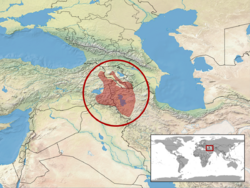Biology:Vipera raddei
| Vipera raddei | |
|---|---|

| |
| Scientific classification | |
| Domain: | Eukaryota |
| Kingdom: | Animalia |
| Phylum: | Chordata |
| Class: | Reptilia |
| Order: | Squamata |
| Suborder: | Serpentes |
| Family: | Viperidae |
| Genus: | Vipera |
| Species: | V. raddei
|
| Binomial name | |
| Vipera raddei Boettger, 1890
| |

| |
| Synonyms | |
| |
Vipera raddei is a venomous viper species found in Armenia, Turkey, Iran, Azerbaijan, and possibly also Iraq. There are two subspecies currently recognized.[4]
Etymology
The specific name, raddei, is in honor of German naturalist Gustav Radde.[5]
Common names
Common names for V. raddei include rock viper, Radde's mountain viper, Kurdistan viper (Vipera raddei kurdistanica),[6] Armenian mountain viper,[7] Armenian viper,[8] Radde's viper,[9] Armenian mountain adder,[10] and Zanjhani viper.[11]
Description
Adult males of V. raddei grow to a maximum total length (including tail) of 99 cm (39 in). Adult females are smaller with a maximum total length of 79 cm (31 in).[7]
Geographic range
V. raddei is found in Eastern Turkey, northwestern Iran, Armenia, Azerbaijan, and probably Iraqi Kurdistan. This species is parapatric or slightly sympatric with V. wagneri in the Aras river valley, Kars Province, eastern Turkey.
The type locality is listed as "Kasikoparan in Armenien ". According to Nilson and Andrén (1986), Kasikoparan, Armenia (40°02'N, 43°26'E) is now part of Turkey (Kazikkiran [Kazikkoparan]), Tuzluca, Kars Province, northeastern Anatolia).[2]
Conservation status
V. raddei is classified as Lower Risk with a subcategory of least concern (LR/lc) according to the IUCN Red List of Threatened Species (v2.3, 1994).[12] This indicates that it has been evaluated, but that it does not satisfy the criteria for any of the categories Critically Endangered, Endangered or Vulnerable. Also, it does not qualify for Conservation Dependent or Near Threatened either. Year assessed: 1996.[13]
It is, however, listed as a protected species (Appendix III) under the Berne Convention.[14]
Taxonomy
V. raddei is apparently closely related to V. albicornuta and V. latifii; together they form the Vipera raddei complex.[2] There are two subspecies: the nominate from Armenia, Azerbaijan, eastern Turkey, northwest Iran, and adjacent Turkmenistan, and V. r. kurdistanica from southeast Turkey and adjacent Iraq and Iran.[4]
See also
- List of viperine species and subspecies
- Viperinae by common name
- Viperinae by taxonomic synonyms
- Snakebite
References
- ↑ Nilson, Göran; Andrén, Claes; Avci, Aziz; Akarsu, Ferdi (2009). "Montivipera raddei ". The IUCN Red List of Threatened Species (IUCN) 2009: e.T22993A9406370. doi:10.2305/IUCN.UK.2009.RLTS.T22993A9406370.en. http://www.iucnredlist.org/details/22993/0. Retrieved 15 January 2018.
- ↑ 2.0 2.1 2.2 McDiarmid RW, Campbell JA, Touré TA (1999). Snake Species of the World: A Taxonomic and Geographic Reference, Volume 1. Washington, District of Columbia: Herpetologists' League. ISBN:1-893777-00-6 (series). 511 pp. ISBN:1-893777-01-4 (volume).
- ↑ "Montivipera raddei ". The Reptile Database. www.reptile-database.org.
- ↑ 4.0 4.1 http://reptile-database.reptarium.cz/species?genus=Montivipera&species=raddei&search_param=%28%28search%3D%27Vipera+raddei%27%29%29
- ↑ Beolens, Bo; Watkins, Michael; Grayson, Michael (2011). The Eponym Dictionary of Reptiles. Baltimore: Johns Hopkins University Press. xiii + 296 pp. ISBN:978-1-4214-0135-5. (Vipera raddei, p. 215).
- ↑ http://www.reptilesmagazine.com/Snakes/Wild-Snakes/Venomous-Snakes-In-Iraq/
- ↑ 7.0 7.1 Mallow D, Ludwig D, Nilson G (2003). True Vipers: Natural History and Toxinology of Old World Vipers. Malabar, Florida: Krieger Publishing Company. 359 pp. ISBN:0-89464-877-2.
- ↑ Mehrtens JM (1987). Living Snakes of the World in Color. New York: Sterling Publishers. 480 pp. ISBN:0-8069-6460-X.
- ↑ Gotch AF (1986). Reptiles – Their Latin Names Explained. Poole, UK: Blandford Press. 176 pp. ISBN:0-7137-1704-1.
- ↑ Brown JH (1973). Toxicology and Pharmacology of Venoms from Poisonous Snakes. Springfield, Illinois: Charles C. Thomas. 184 pp. LCCCN 73-229. ISBN:0-398-02808-7
- ↑ Latifi (1991).
- ↑ Vipera raddei at the IUCN Red List. Accessed 2 September 2007.
- ↑ 1994 Categories & Criteria (version 2.3) at the IUCN Red List. Accessed 2 September 2007.
- ↑ Convention on the Conservation of European Wildlife and Natural Habitats, Appendix III at Council of Europe. Accessed 9 October 2006.
Further reading
- Boettger O (1890). "Eine neue Viper aus Armenien ". Zoologischer Anzeiger 13: 62-64. ("Vipera Raddei n. sp."). (in German).
- Boulenger GA (1896). Catalogue of the Snakes in the British Museum (Natural History). Volume III., Containing the ... Viperidæ. London: Trustees of the British Museum (Natural History). (Taylor and Francis, printers). xiv + 727 pp. + Plates I-XXV. ("Vipera raddii [sic]", p. 487).
- Latifi, Mahmoud (1991). The Snakes of Iran. Oxford, Ohio: Society for the Study of Amphibians and Reptiles. 167 pp. ISBN:0-916984-22-2. (Vipera raddei, Zanjhani viper, p. 134).
- Nilson G, Andrén C (1986). "The mountain vipers of the middle east: The Vipera xanthina complex". Bonner Zoologische Monographien 20: 1-90.
External links
| Wikimedia Commons has media related to Vipera raddei. |
- Montiipera raddei at the Reptarium.cz Reptile Database. Accessed 20 August 2016.
- Vipera (Montivipera) raddei raddei at Checklist of Armenia's Amphibians and Reptiles, Tadevosyan's Herpetological Resources. Accessed 20 August 2016.
Wikidata ☰ Q683693 entry




